Artist Vasily Konovalenko: Keeping Gemstone Carving Art Alive
Was the gemstone carving art under a threat of oblivion?

The art of carving gemstones for the jewelry pieces has been very popular everywhere in the world. It was never under the threat of disappearance. However, the art of carving rigid and firm gemstones to make figurines, assemble colorful sculptures and mosaic compositions from the mixed semi-precious stones and combining stone carving with the complicated enamel techniques – such art style was best developed in the pre-revolutionary Russia. The October Socialist Revolution in 1917 changed not only the political and economic life of Russia and neighboring countries but also destroyed many fine cultural traditions and unique art of tsarist Russia. Fabulous gemstone carving traditions were destroyed by this revolution and new Soviet government.
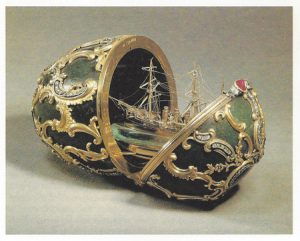
With the advent of Soviet power, the world-famous firm of Peter Carl Gustavovich Fabergé was killed, its owner had to flee Russia. Contemporary and rival firm to the Faberge was the company “Russkiye Samotsvety” (“Russian semi-precious stones”) founded by the artist stone-cutter from Yekaterinburg Alexei Kuzmich Denisov-Uralsky. This company suffered the same fate, and A.K. Denisov-Uralsky ended up in a forced emigration in Finland.
During the years of socialism, a Ukrainian-Russian artist Vasiliy Konovalenko became a delicate thread of the revival and continuation of the traditions of Faberge’s and his contemporaries’ jewelry and stone-carving art. But he, like his predecessors, was overtaken by the sad fate as soon as his name became known and the Soviet government turned its attention to him.
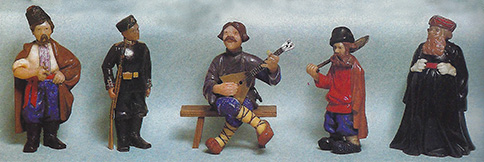
A smooth beginning of the artistic journey.
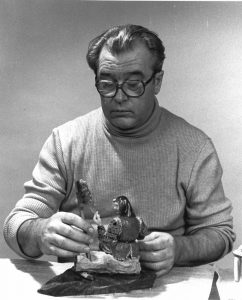
Vasily Vasilievich Konovalenko was born in 1929 in Petrovka – a village in the Zaporozhye region of Ukraine. His father, Vasily Konovalenko, was Ukrainian and his mother, Feodosia Galiguzova, was Russian. Vasily was a fifth child in the family and the only boy. He was only two years old when his family moved to a large mining and industrial center in Eastern Ukraine, the City of Donetsk. At the age of fifteen, Vasily began working in the Donetsk National Academic Theater of the Opera and Ballet as an apprentice set designer. In 1945, he was accepted to work at the Stalin Theater of the Opera and Ballet, and in the following year, he enrolled in the Art and Architecture School at the Donetsk Polytechnic Institute.
During his short service in the Soviet Navy, Konovalenko visited Leningrad (now Saint Petersburg). Immediately, he fell in love with the city and was overwhelmed by its artistic, historic and cultural environment. The military service was mandatory for all young men in the Soviet Union. However, Konovalenko was discharged prematurely after only 5 months due to unspecified and unregistered medical reasons. Shortly after his military discharge, Vasily moved to Leningrad and was employed by the very prestigious Kirov State Academic Theater of the Opera and Ballet (the Mariinsky Theater).
 In the spring of 1957, the Kirov Theater presented the eighth and final ballet by Sergei Prokofiev “The Stone Flower”, the plot of which was based on a tale by Pavel Bazhov’s from his book of tales “Malachite Casket”. Konovalenko was appointed as a lead set designer for this ballet. Among many other responsibilities for the job, Vasily took an extra task on himself: he used his old and little-practiced skill to carve a malachite casket as a prop for the ballet. Little did he know that the completion of this box will change his life path.
In the spring of 1957, the Kirov Theater presented the eighth and final ballet by Sergei Prokofiev “The Stone Flower”, the plot of which was based on a tale by Pavel Bazhov’s from his book of tales “Malachite Casket”. Konovalenko was appointed as a lead set designer for this ballet. Among many other responsibilities for the job, Vasily took an extra task on himself: he used his old and little-practiced skill to carve a malachite casket as a prop for the ballet. Little did he know that the completion of this box will change his life path.
Danila-Master of the 20th century.
Inspired by his malachite box, which came out beautifully, Vasily started his new hobby of a gem carving. He fell in love with this art and began using it in a unique and fascinating way. Vasily Konovalenko created a number of miniature sculptures out of the mixed semi-precious stones, sometimes with an addition of wood and other gifts from nature. Semi-precious malachite, rhodonite, jade, jasper, agate, opals contain an amazing color palette, the richest structural variety. They are used in the jewelry industry. However, the sculptural works of these stones are a rarity, a wonder. Konovalenko’s miniatures introduce original and often humorous episodes from a Russian or Ukrainian village and other scenes of a routine life of the common people. The works of Konovalenko blend the fine art and craftsmanship of a genius with the innocence and simplicity of the folk art. The artist has revived and further developed the most difficult art of carving very firm and yet fragile and delicate gemstones.
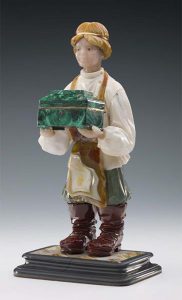
In 1959, the totemic leader of all Kanavalenko’s sculptures was created: Danila – a young and gifted stone cutter, a master, who was enchanted with the secret of the stone flower hidden in the garden of the Mistress of the Copper Mountain. The figure of Danila-Master stands at attention, proudly holding a malachite box he has made, just as Konovalenko has once made a much bigger malachite box for the set of The Stone Flower. Figuratively speaking, Vasily was Danila-Master; people often called Konovalenko by Danila-Master name thus emphasizing his genius.
Unfortunate attempt to get the publicity.
The first masterpieces of stone sculpture created by V. Konovalenko were ready to exhibit in 1959, but he hasn’t been able to receive a formal authorization for an exhibition of his stone-carved compositions for the next 14 years. Unfortunately, in the corrupt Soviet Union, in order to achieve a goal, connections were needed in the proper government institutions. Also, certain personalities and a peculiar skill set were required to convince the important figures in the governing Communist Party that your request has a beneficial impact on the Soviet Union and the Soviet people. Of course, a caring intention in the previous statement is a pure hypocrisy. The true reason was that every little and big boss in the Soviet Union wanted to prove his or her significance and power over the others, and also fill his or her own pockets with the routinely offered bribes.
Konovalenko knew very little on how to deal with the leaders of the Communist Party. He was a gifted and hard-working artist. He preferred to stay away from the politicians in his corrupted country. Vasily continued working for the Kirov theater and unnoticeably honing his stone-carving skills. He traveled extensively to visit mineral sources in the Urals, Siberia, and Ukraine and to meet with geologists and mineralogists. By 1971, Konovalenko’s theatrical reputation was at its summit, but his gem carving was lagging because he had never had a public exhibition.
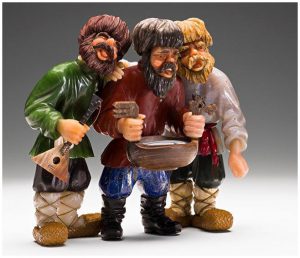
Then, the artist’s wife Anna suggested that they should try to meet with the authorities in Moscow in pursuing an opportunity for Vasily’s personal exhibition. This was a bold decision and the couple made several undesirable steps in their approach to the solution. They didn’t bring a letter of referral from the Communist Party officials in Leningrad. Besides, as a sample of his work, Vasily brought the miniature composition “Brazhniki” (“Roisterers”). It depicted three carousing men and therefore happened to be a rather unwise choice because it didn’t reflect on the Soviet Realism style and the socialist ideology favored by the Communist Party. Anna and Vasily’s request was denied. They safely returned to Leningrad, but didn’t give up their idea.
The first personal exhibition in Saint Petersburg.
Two years later the couple decided to make a second approach. They returned to Moscow. This time, they were prepared better. Through mutual acquaintances, Anna obtained an appointment with the well-known writer, author of the lyrics of the USSR National Anthem, Sergei Michalkov. Konovalenko brought two more-appropriate works: Warrior and The Tsar’s Henchman. S. Mikhalkov loved the sculptures and he used his personal connections to arrange for Konovalenko’s exhibition at the State Russian Museum in Leningrad. The director of the museum, Vasily Pushkarev, knew and admired Konovalenko’s work.
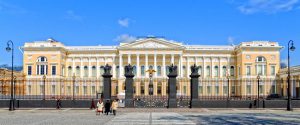
In 1973, when the artist was 44 years old, The State Russian Museum held his personal exhibition. This exhibition had a sensational outcome. Konovalenko’s works were purchased by Gokhran* of Russia as a national treasure. Twice Konovalenko was awarded the gold medal of VDNKh**
Persecution
I wish I could continue the story by saying that “…and Konovalenko family lived happily ever after”. Unfortunately, that’s not the case… When they went to Moscow, they bypassed the top official in Leningrad Grigory Romanov – the First Secretary of the Leningrad Regional Committee of the Communist Party. Thus, Romanov missed on the opportunity to receive a credit for the exhibition. In addition, there was a long-simmering power struggle between Pushkarev and Romanov, and Konovalenkos inserted themselves right in the middle of it. Romanov developed a plan to charge Konovalenko as a criminal, despite the fact that the artist was just announced as a national hero. He engaged the KGB to investigate Konovalenko on the following charges:
1. Konovalenko had been involved in buying and selling precious and semi-precious stones;
2. He had denigrated the Soviet culture by the whimsical nature of his characters;
3. He was in possession of the gold and silver.
Konovalenko was terrified by the KGB investigation. 1,500 people – Konovalenko’s friends, acquaintances, and co-workers, were interviewed in an attempt to gather evidence against him. Konovalenko’s house and his workshop were damaged in a 12-hour long search. Vasily’s friends were working behind-the-scenes to keep him out of prison and a compromise was eventually reached.
Konovalenko agreed to:
1. “Donate” all 10 sculptures displayed in the exhibition to the Soviet State.
Ironically, at the same time, the American businessman Armand Hammer offered to purchase the ten pieces in the exhibit for $150,000 each. The Soviet government declined the offer, and those pieces are still in Moscow.
2. Relocate his family from Leningrad to Moscow,
3. Take a job in the Geological State Museum “Samotsvety” (“Gems”), which at the time was closed for visitors and served as a storage for the minerals and fossils.
When the KGB investigation reached the desk of the Chief Prosecutor of the Soviet Union, he dismissed the case due to the lack of the crime and informally mentioned that he didn’t remember such caricature case since Stalin’s times.
Creativity cannot be mandated
In 1974 Vasily Konovalenko began his work at the “Samotsvety” as a director of the newly formed Laboratory of the Small Sculptural Forms.

He soon found out that much of his work would consist of making pieces for the Communist Party officials as gifts to their colleagues, friends and visiting dignitaries. Vasily realized that he won’t be free again as an artist. He won’t be able to create his lovely humorous scenes from the folk life. Instead, he’d have to make V. Lenin, L. Brezhnev, and the other communist leaders. He was given a task of creating a scene with Vladimir Lenin. Konovalenko started the work, but he couldn’t finish… Lenin’s cap and his boots are still stored in the museum in Moscow, but Lenin himself was never carved.
Also, Konovalenko was never fully relieved from a fear of another KGB investigation: if it happened once, there was a chance that it could happen again. Therefore, when an opportunity to emigrate from the Soviet Union presented itself, he and his family decided to leave the country. In April 1981, Konovalenko family: Vasily, Anna, their daughter Vasilisa and Anna’s son Sergey arrived in New York City, where Anna’s brother Naum Nickolyevsky resided. At last, they were free and a new and a very different life has begun for the artist and his loved ones.
Life in the United States
Soon after their relocation, Anna & Vasily found the sponsors for Vasily’s first project in the United States. An Iranian-born, Russian-speaking American medical supplies’ dealer Raphael Gregorian, a Los Angeles-based diamond dealer Michael Kazanjian and a New-York-based diamond dealer Jack Ortman agreed to sponsor Konovalenko and his work. They arranged for the artist’s personal exhibition in the Denver Museum of Nature and Science (DMNS). However, the things were not as good as they seemed. Unfamiliar with the capitalist business in general and American practice in particular, Konovalenko signed 37-pages contract written in the English language, which he did not fully understand. Under this contract, he agreed to produce 18 sculptures in 2 years. In addition, the unknowingly agreed to a level of compensation that made it difficult to comfortably support his family. In order to fulfill his commitment, he worked long hours and slept only 3 or 4 hours each night. Thus, Vasily happened to be under a lot of stress, which almost killed him. In 1982, less than a year after arriving in the United States, he suffered his first heart attack. Nevertheless, he fulfilled the terms of the contract and produced some of his finest pieces during this two-year period. The grand opening for the Konovalenko’s exhibits in Denver, Colorado was scheduled for November 2, 1983.
A tragic event happened on September 1st, 1983, which nobody could foresee. The Soviet Air Force fighter jet shot down the South Korean passenger airliner serving the flight from New York City to Seoul via Anchorage, Alaska. This violent act instantly created the tensest moment of the Cold War since the 1962 Cuban Missile Crisis. The aggravation of hatred towards the Soviet Union became a serious problem for the exhibition of a Russian art created by a living Russian immigrant. The opening of the exhibition was postponed, but the work behind the scene continued.

The Konovalenko sculptures went on display in DMNS on March 15, 1984, and had a great acclaim. Considering the popularity, the exhibition was extended several times until 1989. During these years several pieces were added to the collection. To complete his numerous orders, Konovalenko organized the studio from the ground up for making stone-cutting sculptures and jewelry. Professional masters worked on Konovalenko’s sketches, but most of the stonework was still done by the artist himself. The wealthiest of the American people purchased some Konovalenko’s sculptures to enrich their private collections. Larry Silverstein, the owner of the World Trade Center, bought two pieces.
The artist’s heritage
Sadly, the American period of the artist’s life ended too soon. Vasily Konovalenko suffered a cerebral hemorrhage and died on January 27, 1989. Vasily Konovalenko is buried in the cemetery of the Russian Orthodox Convent ‘Novo Diveevo’ in Nanuet, New York.
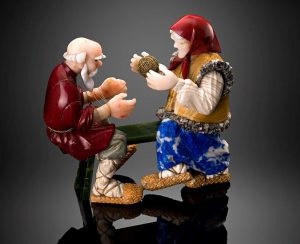
All the DMNS exhibits were bought by the sponsors and permanently donated to the Denver museum. It was the highest appreciation of the master’s work in the jewelry world. In his lifetime, Vasiliy Konovalenko created over 60 gemstone compositions. Nowadays, a part of Konovalenko’s collection remains in Moscow, 20 pieces are permanently displayed in two halls of the Denver Museum of Nature and Science in Colorado, and several pieces are privately owned.
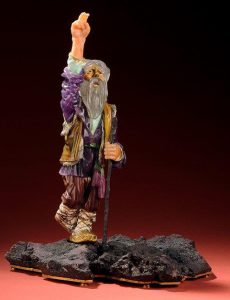
I wish that more people in the world would know Vasily Konovalenko’s name and recognize his talent. At the time of my writing, the video I shared above “Vasily Konovalenko — Revelation of the Stone (English Version)” had only 150 views on YouTube. I truly believe that V. Konovalenko deserves better publicity, recognition and worldwide acknowledgment of his genius.
Amazon offers a book in English with more details on Vasily Konovalenko life and his art. If interested, please click on the picture below.
I was very excited to discover the artworks of this incredible sculptor and jeweler and learn his story. When I visited Denver, CO many years ago, I haven’t heard yet of Vasily Konovalenko and an exhibition of his works in the DMNS. Here is a good reason to visit Denver again. I hope you enjoyed the story and fall in love with Konovalenko’s miniature compositions. Please share your thoughts and ask questions below in the “Comment” field.
~ Julia
* Gokhran of Russia (source – Wikipedia): “The State Administration for the Formation of the State Fund of Precious Metals and Precious Stones of the Russian Federation, storage, dispensing and use of precious metals and precious stones under the Ministry of Finance”. – Wikipedia
** VDNKh – Vystavka Dostizheniy Narodnogo Khozyaystva: “Exhibition of Achievements of National Economy is a permanent general-purpose trade show and amusement park in Moscow, Russia.” – Wikipedia
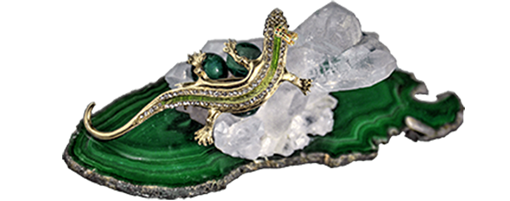
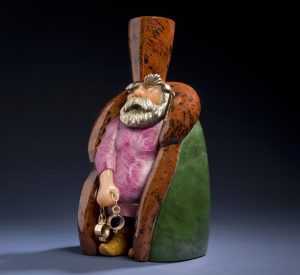
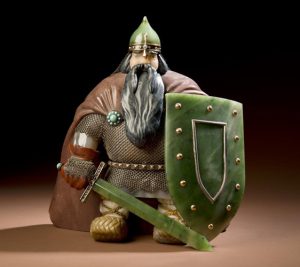

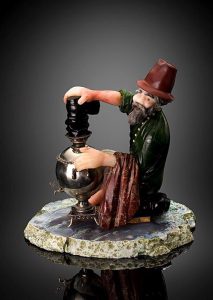
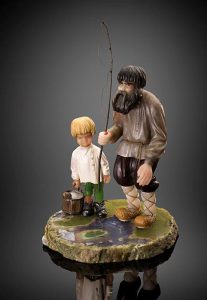

Hi Julia, I love your website as I am a gemstone lover. I love reading about Tourmaline and Malachite. I even took notes. I was engrossed reading about the artist Vasily Konovalenko. Too bad his life as an artist did not really flourish in Russia. He became successful and famous when he came to the US only for him to have a failing health that shortened his life as an artists. Kind of sad for me. You were limited to just 2 gemstones in your site, and I wonder. It would have been nice if you had a little bit more, like maybe diamonds, emeralds or ruby. I hope you can feature more in your next blog. I’ll be watching. Thanks to a wonderful site of gems.
Dear Rebecca,
Thank you so much for your interest and your lovely feedback.
Unfortunately, most Russian stonecutters had a very short lifespan, especially the masters from the Urals in XVIII-XIX century. 60 years that Konovalenko has lived can be considered “good luck”. Stone cutting work is very toxic: the dust from carving gets into the lungs, many minerals release hazardous matter: Lead, Mercury, Arsenic. These substances are not of, or of very little concern when they are in a finished product, but definitely, harm the artist while he is working with them. While Konovalenko lived in Russia and was not recognized as a jeweler and stone cutter, he didn’t have an equipped studio and worked in his apartment. In the US, he had his own workshop providing as much safety as was known to be needed over 40 years ago. He was under the stress, which sped up an eruption of his long-lasting and smoldering illness.
I hear your advice on covering more gemstones. Thank you for it. My site is very new, and I am constantly working on it. I want to share my knowledge with people like you who share my passion. But, when I take a topic I think that I know a lot about, it takes me deeper and deeper and I discover more and more new and fascinating facts, which I also want to write about. The research and discovery of new material slows down my writing of a current article. Please do check back often as my site will grow every week.
All the best,
Julia
Fascinating staff! So unusual and interesting. I have always liked jess tones, but I did not know many things you write about. Thank you, Julia!
Dear Marianna,
thank you for reading. I appreciate your feedback.
Who is Jess Tones?
Best,
~ Julia
I think they mean ‘gem stones’ not ‘Jess Tones’
I visited the museum in 1985 & then I moved to Denver. I frequently visit the DMSN and the gem carvings are my favorite. His life was too short, now that I too am 60. I noticed he used dinosaur fossils for a handkerchief on one of his sculptures. I wonder if the museum donated the fossil to him? I’m also wondering what these are valued at. Armand Hammer only offered $150,000 for the lot! That’s clearly not enough!
Hi Julia,
thank you so much for your presentation. Konovalenkov’s pieces are my absolute favorite exhibit here at the Denver Museum, I would never tire of seeing and feel very lucky to find it here.
As a Naturalist, I am a lover of minerals and gemstones and it is sheer delight to see what he was able to create. I have forwarded this link to friends to see. Thank you so much, Gabriella
Dear Gabriella,
Thank you so much for your lovely feedback and for sharing my post with your friends. I envy you for being able to see the exhibit whenever you feel like visiting it. 🙂 I love gems and minerals too, and I also love fine artwork that only a few masters carve out of gemstones!
Julia,
Thank you for the great article! My wife and I have seen the Denver exhibit several times, however we didn’t know anything about his life. It’s tragic to learn how he was treated and what he went through with the Soviet government- though it’s not a surprise.
His life was cut way too short, though his legacy will live on through the exhibit in Denver. We plan to buy the book by Stephen Nash. Hopefully Mr. Konovalenko’s story will grow over time.